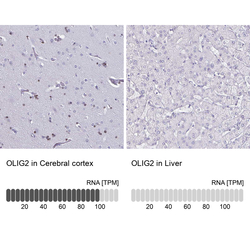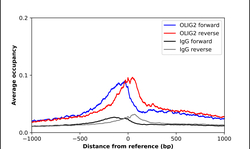Antibody data
- Antibody Data
- Antigen structure
- References [9]
- Comments [0]
- Validations
- Immunohistochemistry [1]
- Chromatin Immunoprecipitation [1]
Submit
Validation data
Reference
Comment
Report error
- Product number
- HPA003254 - Provider product page

- Provider
- Atlas Antibodies
- Proper citation
- Atlas Antibodies Cat#HPA003254, RRID:AB_1854795
- Product name
- Anti-OLIG2
- Antibody type
- Polyclonal
- Description
- Polyclonal Antibody against Human OLIG2, Gene description: oligodendrocyte lineage transcription factor 2, Alternative Gene Names: BHLHB1, bHLHe19, OLIGO2, PRKCBP2, RACK17, Validated applications: ChIP, IHC, WB, Uniprot ID: Q13516, Storage: Store at +4°C for short term storage. Long time storage is recommended at -20°C.
- Reactivity
- Human
- Host
- Rabbit
- Conjugate
- Unconjugated
- Isotype
- IgG
- Vial size
- 100 µl
- Concentration
- 0.3 mg/ml
- Storage
- Store at +4°C for short term storage. Long time storage is recommended at -20°C.
- Handling
- The antibody solution should be gently mixed before use.
Submitted references Selective suppression of oligodendrocyte-derived amyloid beta rescues neuronal dysfunction in Alzheimer's disease.
Spatiotemporal, optogenetic control of gene expression in organoids
In-vitro engineered human cerebral tissues mimic pathological circuit disturbances in 3D
Preclinical Evaluation of Sodium Selenite in Mice: Toxicological and Tumor Regression Studies after Striatum Implantation of Human Glioblastoma Stem Cells
Age-related loss of axonal regeneration is reflected by the level of local translation.
Mature oligodendrocytes bordering lesions limit demyelination and favor myelin repair via heparan sulfate production
Altered human oligodendrocyte heterogeneity in multiple sclerosis
Single-cell transcriptomic analysis of Alzheimer's disease.
Disease-specific oligodendrocyte lineage cells arise in multiple sclerosis
Rajani RM, Ellingford R, Hellmuth M, Harris SS, Taso OS, Graykowski D, Lam FKW, Arber C, Fertan E, Danial JSH, Swire M, Lloyd M, Giovannucci TA, Bourdenx M, Klenerman D, Vassar R, Wray S, Sala Frigerio C, Busche MA
PLoS biology 2024 Jul;22(7):e3002727
PLoS biology 2024 Jul;22(7):e3002727
Spatiotemporal, optogenetic control of gene expression in organoids
Legnini I, Emmenegger L, Zappulo A, Rybak-Wolf A, Wurmus R, Martinez A, Jara C, Boltengagen A, Hessler T, Mastrobuoni G, Kempa S, Zinzen R, Woehler A, Rajewsky N
Nature Methods 2023;20(10):1544-1552
Nature Methods 2023;20(10):1544-1552
In-vitro engineered human cerebral tissues mimic pathological circuit disturbances in 3D
Saberi A, Aldenkamp A, Kurniawan N, Bouten C
Communications Biology 2022;5(1)
Communications Biology 2022;5(1)
Preclinical Evaluation of Sodium Selenite in Mice: Toxicological and Tumor Regression Studies after Striatum Implantation of Human Glioblastoma Stem Cells
Larrouquère L, Berthier S, Chovelon B, Garrel C, Vacchina V, Paucot H, Boutonnat J, Faure P, Hazane-Puch F
International Journal of Molecular Sciences 2021;22(19):10646
International Journal of Molecular Sciences 2021;22(19):10646
Age-related loss of axonal regeneration is reflected by the level of local translation.
van Erp S, van Berkel AA, Feenstra EM, Sahoo PK, Wagstaff LJ, Twiss JL, Fawcett JW, Eva R, Ffrench-Constant C
Experimental neurology 2021 May;339:113594
Experimental neurology 2021 May;339:113594
Mature oligodendrocytes bordering lesions limit demyelination and favor myelin repair via heparan sulfate production
Macchi M, Magalon K, Zimmer C, Peeva E, El Waly B, Brousse B, Jaekel S, Grobe K, Kiefer F, Williams A, Cayre M, Durbec P
eLife 2020;9
eLife 2020;9
Altered human oligodendrocyte heterogeneity in multiple sclerosis
Jäkel S, Agirre E, Mendanha Falcão A, van Bruggen D, Lee K, Knuesel I, Malhotra D, ffrench-Constant C, Williams A, Castelo-Branco G
Nature 2019;566(7745):543-547
Nature 2019;566(7745):543-547
Single-cell transcriptomic analysis of Alzheimer's disease.
Mathys H, Davila-Velderrain J, Peng Z, Gao F, Mohammadi S, Young JZ, Menon M, He L, Abdurrob F, Jiang X, Martorell AJ, Ransohoff RM, Hafler BP, Bennett DA, Kellis M, Tsai LH
Nature 2019 Jun;570(7761):332-337
Nature 2019 Jun;570(7761):332-337
Disease-specific oligodendrocyte lineage cells arise in multiple sclerosis
Falcão A, van Bruggen D, Marques S, Meijer M, Jäkel S, Agirre E, Samudyata , Floriddia E, Vanichkina D, ffrench-Constant C, Williams A, Guerreiro-Cacais A, Castelo-Branco G
Nature Medicine 2018;24(12):1837-1844
Nature Medicine 2018;24(12):1837-1844
No comments: Submit comment
Supportive validation
- Submitted by
- Atlas Antibodies (provider)
- Enhanced method
- Orthogonal validation
- Main image

- Experimental details
- Immunohistochemistry analysis in human cerebral cortex and liver tissues using HPA003254 antibody. Corresponding OLIG2 RNA-seq data are presented for the same tissues.
- Sample type
- Human
- Protocol
- Protocol
Supportive validation
- Submitted by
- Atlas Antibodies (provider)
- Main image

- Experimental details
- ChIP-Exo-Seq composite graph for Anti-OLIG2 (HPA003254, Lot 000047004) tested in K562 cells. Strand-specific reads (blue: forward, red: reverse) and IgG controls (black: forward, grey: reverse) are plotted against the distance from a composite set of reference binding sites. The antibody exhibits robust target enrichment compared to a non-specific IgG control and precisely reveals its structural organization around the binding site. Data generated by Prof. B. F. Pugh´s Lab at Cornell University.
 Explore
Explore Validate
Validate Learn
Learn Western blot
Western blot Immunohistochemistry
Immunohistochemistry